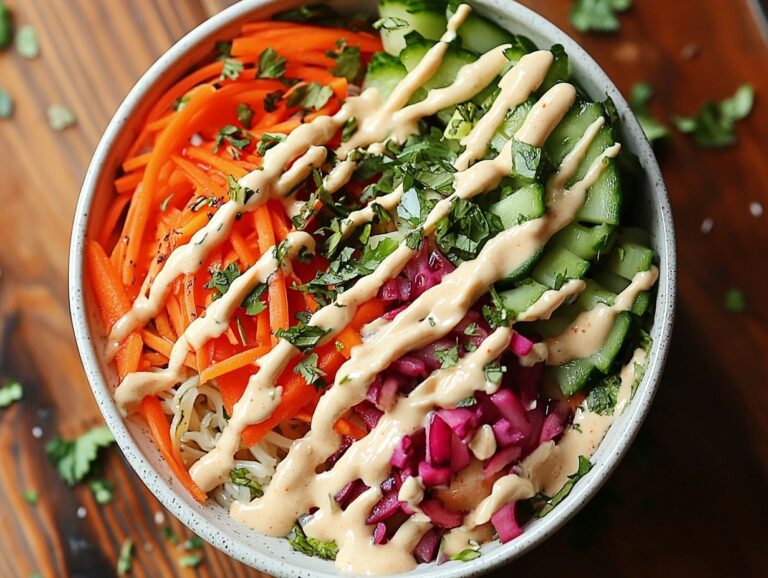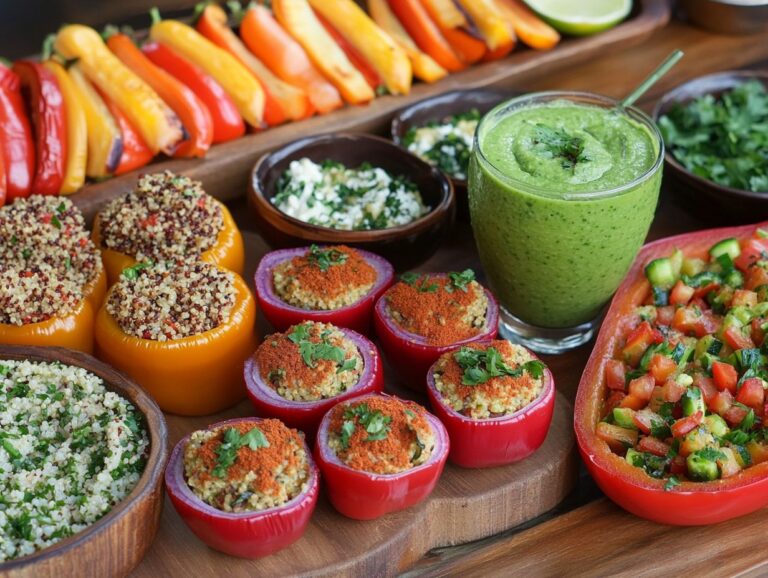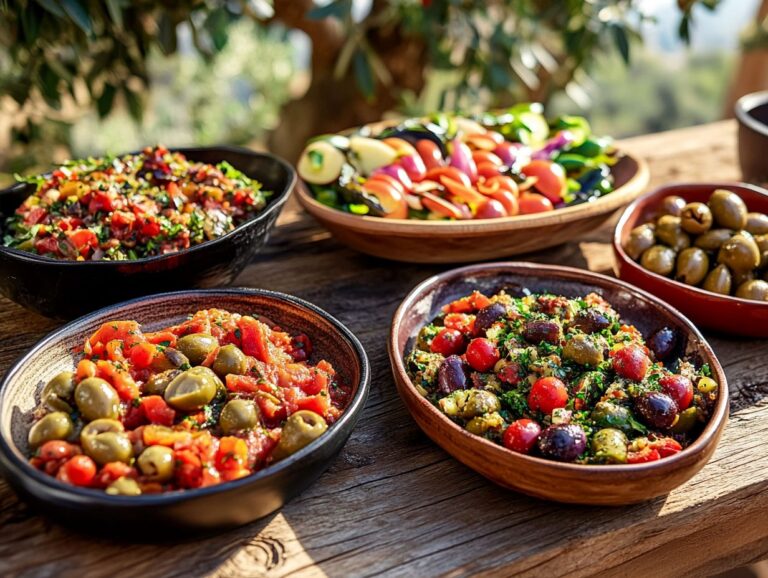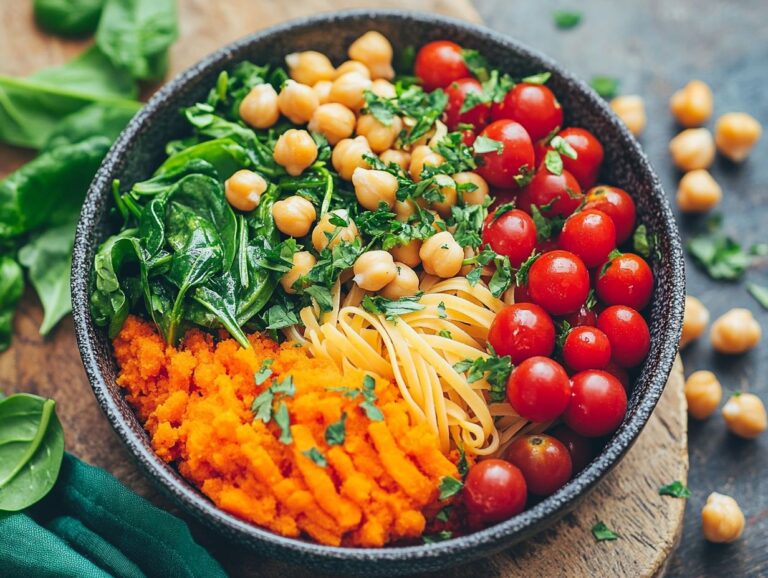Italian cuisine, celebrated for its rich flavors and comforting dishes, can seamlessly incorporate a vegan twist without compromising on taste. This article delves into how traditional Italian favorites can be transformed into delightful plant-based options. From a hearty vegan lasagna to a creamy mushroom risotto, you will learn how to replicate the classic flavors you love. Essential ingredients, substitutions, and cooking tips will enhance your experience in vegan Italian cooking, allowing you to explore the rustic charm of Mediterranean flavors while embracing Italy’s culinary heritage. Prepare to impress both your palate and your guests!
What Makes Italian Food Vegan?
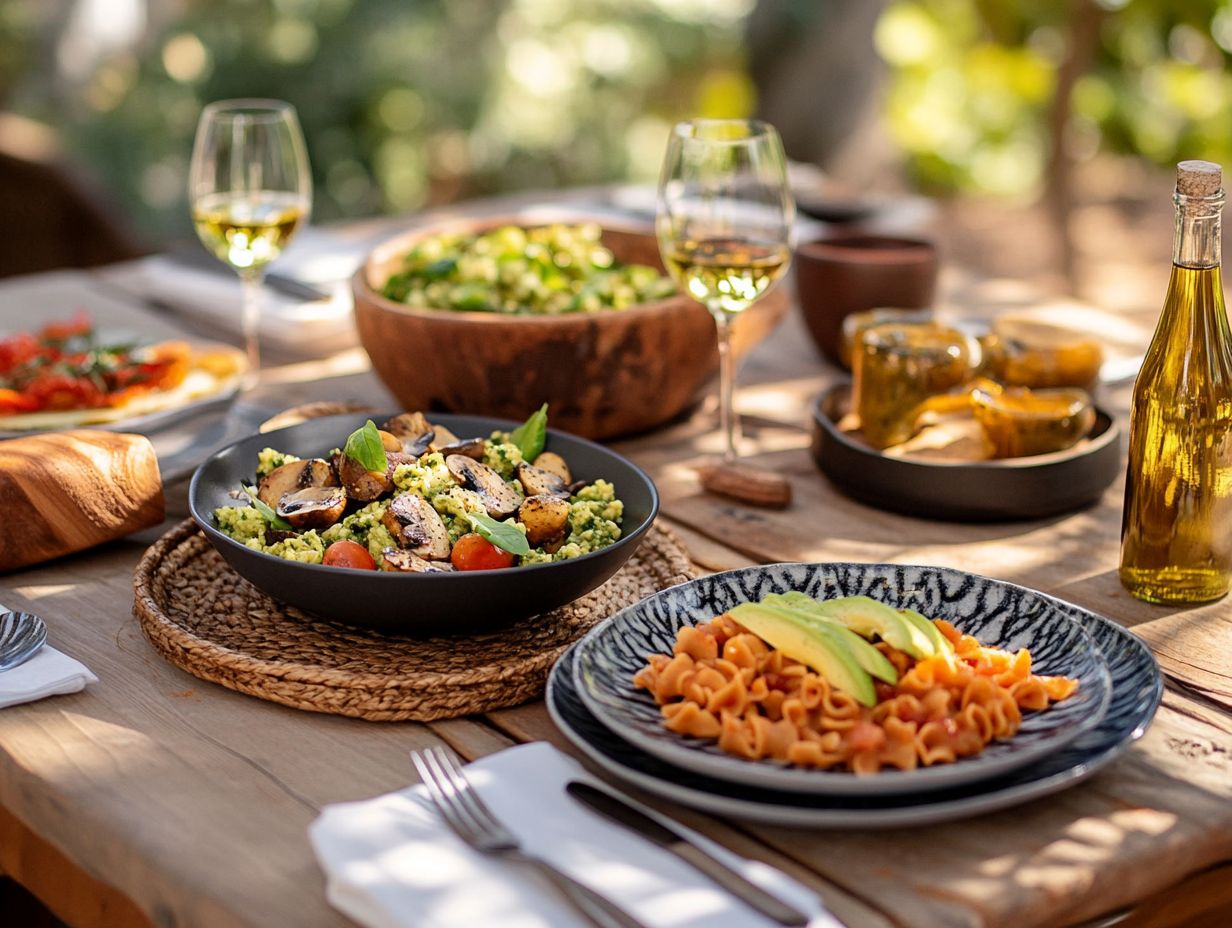 Discover how vibrant salads, vegetable-based appetizers, and delicious sauces embody the essence of vegan Italian cuisine. Vegan Italian cuisine embraces Mediterranean cooking styles and plant-based ingredients to craft flavorful versions of traditional Italian dishes, such as tomato bruschetta and roasted bell peppers. This culinary approach highlights fresh vegetables, high-quality ingredients, and a respect for culinary traditions, providing a satisfying and rustic dining experience reminiscent of Italy’s diverse regional cuisines. The emphasis on flavor and texture in vegan Italian food showcases the health and ethical benefits of a plant-based diet, utilizing ingredients that reflect the country, region, and season. Staples like chickpeas, lentils, and seasonal vegetables are employed to create unique interpretations of classic dishes, whether it’s pasta like spaghetti aglio e olio or pasta alla Norma, or soups such as Tuscan white bean soup. In this context, the principles of vegan cooking underscore the significance of traditional flavors and emphasize the use of the most vibrant parts of plants. This encourages exploration of the rich and diverse array of Italian herbs and spices, with ingredients like basil, oregano, and sun-dried tomatoes enhancing the taste of vegan dishes. Prioritizing high-quality produce not only supports local farmers and sustainable practices but also contributes to the overall enjoyment of the meal. Furthermore, adaptability is a key principle of this culinary style. By respecting original recipes while inviting creativity, veganism allows food enthusiasts to engage in the art of improvisation, leading to the creation of exciting new variations.
Discover how vibrant salads, vegetable-based appetizers, and delicious sauces embody the essence of vegan Italian cuisine. Vegan Italian cuisine embraces Mediterranean cooking styles and plant-based ingredients to craft flavorful versions of traditional Italian dishes, such as tomato bruschetta and roasted bell peppers. This culinary approach highlights fresh vegetables, high-quality ingredients, and a respect for culinary traditions, providing a satisfying and rustic dining experience reminiscent of Italy’s diverse regional cuisines. The emphasis on flavor and texture in vegan Italian food showcases the health and ethical benefits of a plant-based diet, utilizing ingredients that reflect the country, region, and season. Staples like chickpeas, lentils, and seasonal vegetables are employed to create unique interpretations of classic dishes, whether it’s pasta like spaghetti aglio e olio or pasta alla Norma, or soups such as Tuscan white bean soup. In this context, the principles of vegan cooking underscore the significance of traditional flavors and emphasize the use of the most vibrant parts of plants. This encourages exploration of the rich and diverse array of Italian herbs and spices, with ingredients like basil, oregano, and sun-dried tomatoes enhancing the taste of vegan dishes. Prioritizing high-quality produce not only supports local farmers and sustainable practices but also contributes to the overall enjoyment of the meal. Furthermore, adaptability is a key principle of this culinary style. By respecting original recipes while inviting creativity, veganism allows food enthusiasts to engage in the art of improvisation, leading to the creation of exciting new variations.
Classic Italian Dishes Made Vegan
Classic Italian dishes can be creatively reimagined to accommodate a vegan lifestyle, enabling food enthusiasts to savor their favorite flavors while following a plant-based diet, such as vegan cannolo or egg-free biscotti for a homemade dessert. Options abound, from hearty pasta dishes like vegan carbonara and penne arrabbiata to comfort food staples such as vegan lasagna and eggplant parmesan. These recipes make use of innovative ingredients, including vegan melted cheese and vegan parmesan, that replicate the richness of traditional cheeses and sauces, ensuring a satisfying dining experience for everyone at the table. By incorporating seasonal produce and high-quality ingredients, vegan Italian cuisine has the potential to delight the senses with dishes like lentil bolognese or mushroom rag while promoting a healthier lifestyle.
Vegan Lasagna
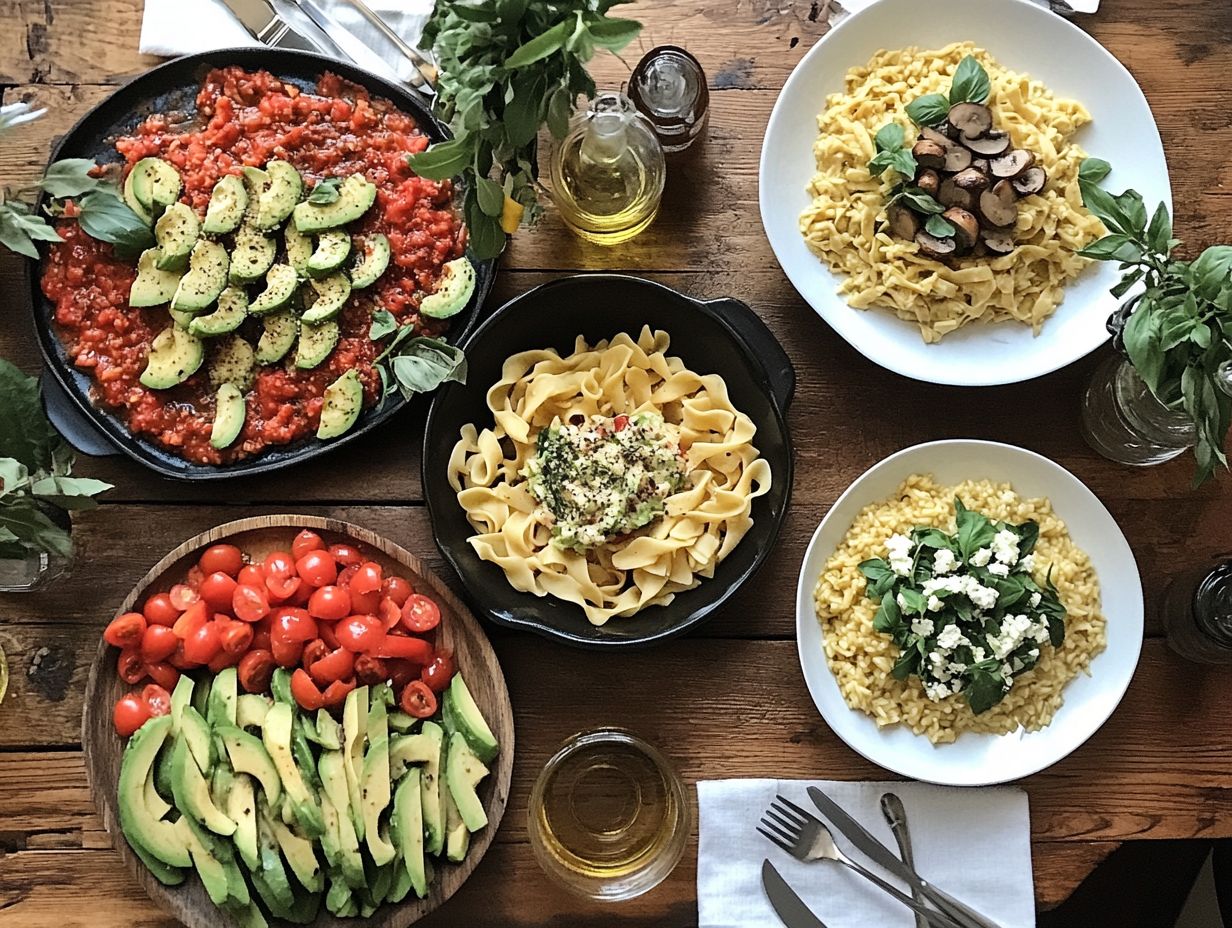 Vegan lasagna is a delicious and filling alternative to traditional lasagna, featuring layers of pasta filled with colorful vegetables and creamy sauces made from plant-based ingredients. This dish can be prepared using high-quality components such as vegan ricotta or a mixture of cashews and nutritional yeast to mimic the richness of cheese. Including seasonal vegetables like spinach, zucchini, and mushrooms not only enhances the flavor but also boosts the nutritional value, making vegan lasagna an excellent choice for any gathering or family meal. To create the perfect vegan lasagna, follow these simple steps:
Vegan lasagna is a delicious and filling alternative to traditional lasagna, featuring layers of pasta filled with colorful vegetables and creamy sauces made from plant-based ingredients. This dish can be prepared using high-quality components such as vegan ricotta or a mixture of cashews and nutritional yeast to mimic the richness of cheese. Including seasonal vegetables like spinach, zucchini, and mushrooms not only enhances the flavor but also boosts the nutritional value, making vegan lasagna an excellent choice for any gathering or family meal. To create the perfect vegan lasagna, follow these simple steps:
- Choose Fresh Ingredients: A homemade sauce made with ripe tomatoes and a vibrant assortment of vegetables will elevate the dish’s flavor.
- Layering is Key: Begin with a layer of marinara sauce, followed by sheets of lasagna noodles, generous dollops of the creamy vegan ricotta, and a layer of saut ed vegetables. Repeat these layers until you are close to the top of the baking tray, finishing with a layer of marinara sauce and a creamy b chamel topping made from almond milk and flour.
- Achieve Creamy Texture: For a smooth consistency, blend the vegan ricotta until it reaches a creamy texture and add a splash of lemon juice for brightness, which also works well in dishes like lemon tofu or pan-fried tofu.
- Opt for Fresh, Organic Vegetables: Using fresh, organic vegetables will enhance the flavor and nutritional profile of your vegan lasagna, similar to the benefits found in vibrant panzanella salad or tomato cucumber onion salad.
Vegan Eggplant Parmesan
Vegan eggplant parmesan is a plant-based alternative to the classic Italian dish, featuring layers of breaded and baked eggplant, homemade tomato sauce, and vegan cheeses. By using high-quality ingredients and traditional flavors, this version captures the taste and texture of the original while remaining entirely plant-based. The preparation typically involves salting the eggplant to draw out moisture and bitterness, which is crucial for achieving a delicious, satisfying, and healthy final product. Like its non-vegan counterpart, vegan eggplant parmesan is a rich dish that makes for an excellent special occasion meal or comfort food. To begin preparing this delightful dish, the eggplant is sliced into even pieces to ensure uniform cooking. Salting the slices is essential for extracting excess moisture and enhancing flavor, resulting in a more delicious outcome. After rinsing and drying the slices, they are ready to be breaded. A mixture of breadcrumbs, nutritional yeast, and Italian herbs creates a crunchy coating that perfectly complements the softness of the eggplant. Once baked, the layers are assembled with a flavorful tomato sauce and a generous amount of vegan cheese either cashew-based or soy-based to add creaminess. This summary outlines the key steps involved in preparing this delectable meal.
Vegan Mushroom Risotto
 Vegan mushroom risotto is a comforting dish that boasts a smooth, creamy texture and earthy flavors, all without the use of dairy, similar to a creamy tomato risotto. Crafted with high-quality ingredients like arborio rice and a variety of mushrooms, this plant-based risotto closely resembles traditional mushroom risotto in both taste and texture. The creaminess of the dish is achieved through the gradual addition of vegetable stock and the incorporation of vegan ricotta or other creamy sauces, making it suitable for any occasion, whether as a main course or a side dish paired with focaccia. Type of Rice: Arborio rice is the preferred choice for mushroom risotto. This short-grain rice is rich in starch, which contributes to the dish’s creamy texture. Due to its higher starch content, arborio rice creates a velvety mouthfeel. Flavors: Traditional risotto typically features a base of mushrooms, shallots, and garlic. Fresh mushrooms enhance the flavor profile and provide a hearty, meaty texture. These ingredients are combined with olive oil or vegan butter to enrich the mouthfeel and overall flavor. When the rice is added, it should be lightly toasted before gradually incorporating warm vegetable stock, ladle by ladle, while stirring continuously. This method ensures even cooking and allows the rice to absorb flavors incrementally. To further elevate the dish, fresh herbs like thyme or parsley can be added, along with a sprinkle of nutritional yeast. Fresh herbs contribute depth to the flavors, while nutritional yeast delivers the umami taste that is often lacking in vegan dishes.
Vegan mushroom risotto is a comforting dish that boasts a smooth, creamy texture and earthy flavors, all without the use of dairy, similar to a creamy tomato risotto. Crafted with high-quality ingredients like arborio rice and a variety of mushrooms, this plant-based risotto closely resembles traditional mushroom risotto in both taste and texture. The creaminess of the dish is achieved through the gradual addition of vegetable stock and the incorporation of vegan ricotta or other creamy sauces, making it suitable for any occasion, whether as a main course or a side dish paired with focaccia. Type of Rice: Arborio rice is the preferred choice for mushroom risotto. This short-grain rice is rich in starch, which contributes to the dish’s creamy texture. Due to its higher starch content, arborio rice creates a velvety mouthfeel. Flavors: Traditional risotto typically features a base of mushrooms, shallots, and garlic. Fresh mushrooms enhance the flavor profile and provide a hearty, meaty texture. These ingredients are combined with olive oil or vegan butter to enrich the mouthfeel and overall flavor. When the rice is added, it should be lightly toasted before gradually incorporating warm vegetable stock, ladle by ladle, while stirring continuously. This method ensures even cooking and allows the rice to absorb flavors incrementally. To further elevate the dish, fresh herbs like thyme or parsley can be added, along with a sprinkle of nutritional yeast. Fresh herbs contribute depth to the flavors, while nutritional yeast delivers the umami taste that is often lacking in vegan dishes.
Ingredients and Substitutions for Vegan Italian Cooking
Understanding Italian food ingredients and their plant-based alternatives is essential in vegan Italian cooking to retain the authentic flavors of traditional cuisine in new vegan preparations. Utilizing high-quality ingredients such as fresh vegetables, legumes, and grains helps maintain the integrity of classic Italian dishes. For instance, vegan ricotta, made from almond or soy, can be used as a substitute for dairy cheese in recipes that require cheese. Additionally, lentils can replace ground beef in recipes like traditional Bolognese, offering a delicious plant-based alternative.
Replacing Meat and Dairy
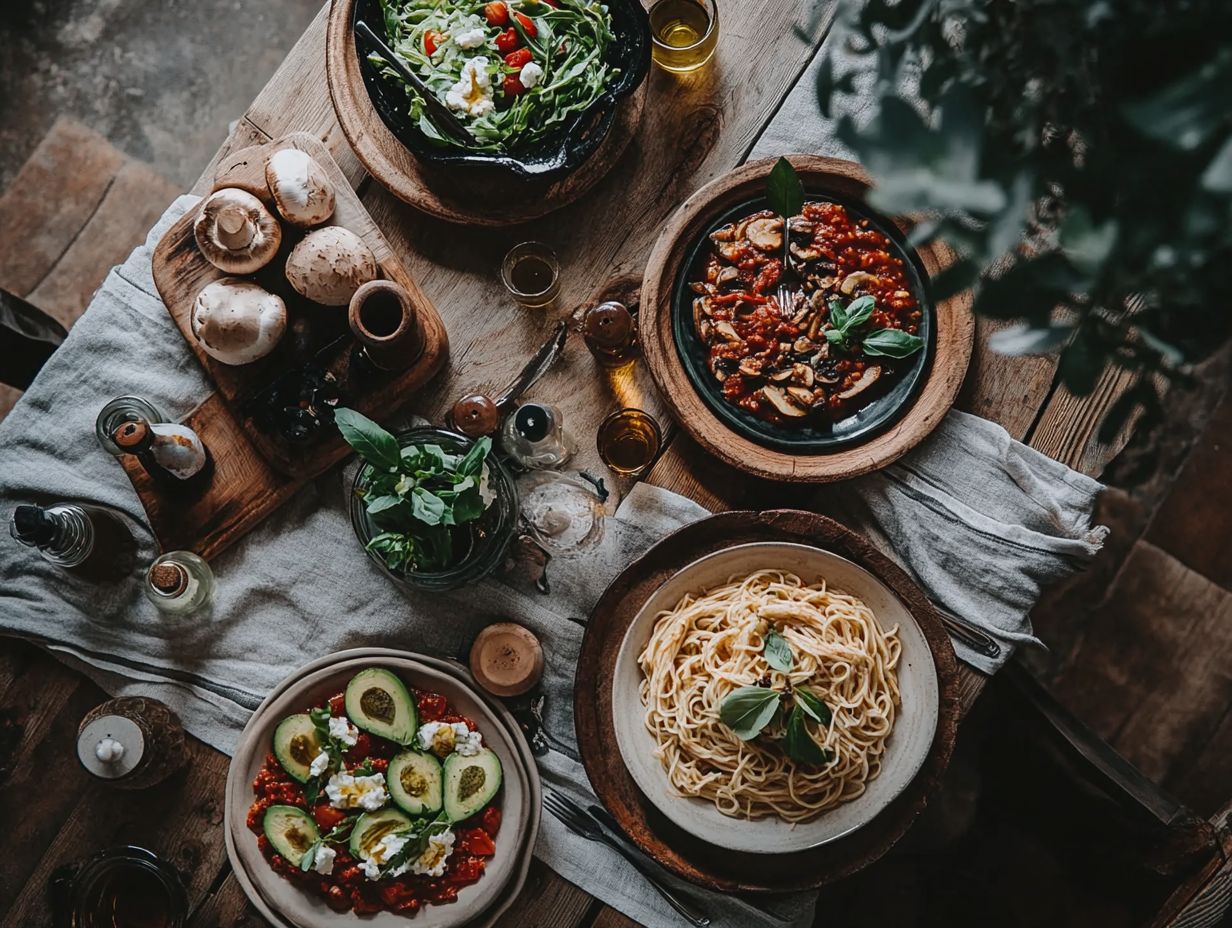 Replacing meat and dairy in traditional Italian recipes requires creativity and an understanding of plant-based alternatives that can mimic the textures and flavors of their non-vegan counterparts. For example, hearty lentils and chickpeas can effectively substitute meat in pasta dishes or stews, while various nuts and seeds can create creamy sauces that replicate dairy products. Mastering the balance of flavors with these substitutions is essential to achieving a satisfying dining experience that honors authentic Italian cuisine. One effective approach is to use mushrooms, particularly portobello or shiitake varieties, which provide a rich umami flavor and a substantial texture reminiscent of meat, ideal for a mushroom rag or braised artichokes. Nutritional yeast can add a cheesy and nutty element to sauces and casseroles, enhancing the overall depth of flavor, much like in vegan cheeses or when balancing flavors in a creamy sauce. When preparing a classic marinara, blending cashews or soaking almonds can yield a luscious, dairy-free creamy accompaniment that offers a satisfying mouthfeel, akin to the experience of enjoying a traditional Italian marinara sauce with piadina or farinata. For those looking for a fun twist, using zucchini noodles not only lightens the dish but also introduces an exciting way to enjoy familiar flavors without the heaviness that meat and dairy can bring.
Replacing meat and dairy in traditional Italian recipes requires creativity and an understanding of plant-based alternatives that can mimic the textures and flavors of their non-vegan counterparts. For example, hearty lentils and chickpeas can effectively substitute meat in pasta dishes or stews, while various nuts and seeds can create creamy sauces that replicate dairy products. Mastering the balance of flavors with these substitutions is essential to achieving a satisfying dining experience that honors authentic Italian cuisine. One effective approach is to use mushrooms, particularly portobello or shiitake varieties, which provide a rich umami flavor and a substantial texture reminiscent of meat, ideal for a mushroom rag or braised artichokes. Nutritional yeast can add a cheesy and nutty element to sauces and casseroles, enhancing the overall depth of flavor, much like in vegan cheeses or when balancing flavors in a creamy sauce. When preparing a classic marinara, blending cashews or soaking almonds can yield a luscious, dairy-free creamy accompaniment that offers a satisfying mouthfeel, akin to the experience of enjoying a traditional Italian marinara sauce with piadina or farinata. For those looking for a fun twist, using zucchini noodles not only lightens the dish but also introduces an exciting way to enjoy familiar flavors without the heaviness that meat and dairy can bring.
Using Fresh Herbs and Spices
Fresh herbs and spices play a crucial role in vegan Italian cooking by enhancing the flavor of plant-based dishes and adding depth to traditional recipes. Staples like basil, oregano, and parsley are essential in Italian cuisine, while spices such as garlic and pepper contribute complexity and aroma. When used thoughtfully, herbs and spices elevate vegan dishes, providing an authentic and vibrant culinary experience that showcases Italy’s rich gastronomic heritage. The artistry of vegan Italian cooking lies in balancing these bright flavors. For instance, fresh basil can be transformed into a vibrant pesto that complements everything from pasta to roasted vegetables. Oregano, known for its robust and earthy flavor, is ideal for enriching tomato sauces or sprinkling over pizzas and traditional Italian recipes. A dash of red pepper flakes can introduce a subtle kick to otherwise mild dishes, while roasted bell peppers add a smoky depth to Mediterranean flavors. It is important to use high-quality organic herbs to maximize their potency, as the success of a dish ultimately depends on freshness. This attention to detail creates an experiential feast that truly honors the love of Italian cooking and its rich culinary heritage.
Tips for Cooking Flavorful Vegan Italian Dishes
Flavorful vegan Italian dishes can be created through careful selection of cooking methods and quality ingredients that maximize taste. An appealing and authentic presentation, along with thoughtful garnishing, can transform a simple meal into a satisfying dining experience. Techniques such as saut ing, steaming, roasting, and braising enhance the flavors of plant-based ingredients and are essential for achieving excellent taste without relying on meat or dairy. This is especially important for creating delicious sauces like creamy tomato risotto or vegan carbonara. Creative presentation and garnishing ideas elevate a simple meal, evoking the rustic charm and ambiance of authentic Italian dining.
Enhancing Flavors with Cooking Techniques
Cooking techniques that enhance flavors are crucial for ensuring that vegan Italian meals maintain the same traditional flavors and flavor profiles as their non-vegan counterparts. Methods such as saut ing garlic in olive oil, caramelizing onions, or roasting vegetables can significantly elevate a dish’s flavor and improve its presentation. For example, slow-cooking tomato sauce allows the flavors to meld beautifully, often resulting in a richer, more complex taste that captures the essence of Italian cuisine. Adding fresh herbs like basil or oregano near the end of the cooking process can provide a burst of freshness and a delightful aroma. Textures are equally important; quickly blanching greens before adding them to a pasta dish helps preserve their vibrant color, while frying capers or olives introduces a satisfying crunch. Incorporating fresh vegetables like zucchini and eggplant can also add to the textural variety. Thoughtfully combining these techniques can elevate any vegan Italian meal to new heights.
Presentation and Garnishing Ideas
The presentation of vegan Italian dishes is crucial, as visual appeal significantly enhances the overall enjoyment of a meal. Simple garnishing ideas, such as sprigs of fresh basil, a drizzle of high-quality olive oil, or a sprinkle of finely ground vegan parmesan cheese, can instantly elevate a dish’s appearance. Consider adding elements like vegan ricotta or lemon tofu to maintain a contrast of flavors and textures. Employing basic plating techniques and colorful arrangements can transform everyday meals into visual masterpieces that embody the rustic charm of Italian cuisine. Along with these fundamental enhancements, the following suggestions can make any vegan Italian dish more appealing:
- Vibrant vegetables and edible flowers: Incorporating colorful vegetables like tomatoes and zucchini, or edible flowers such as nasturtium, pansy, or marigold, adds a splash of color and texture while introducing additional nutrition and flavor to the dish.
- Varied serving vessels: Presenting the dish on rustic wooden boards or elegant ceramic plates creates an atmosphere that resonates with traditional Italian aesthetics.
- Layering ingredients: This technique adds depth and dimension to the dish, evoking memories or stories associated with different parts of the meal.
- Contrasting colors and textures: Using contrasting colors and textures not only enhances the visual appeal but also encourages diners to engage more interactively with the flavors.
- Fresh herbs or a lemon wedge: Adding a side of fresh herbs or a citrus wedge enhances the presentation and provides a refreshing touch to the dish.


